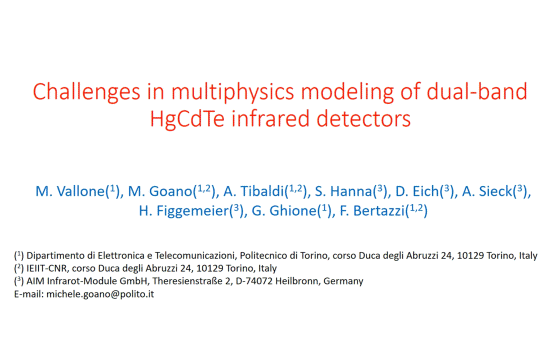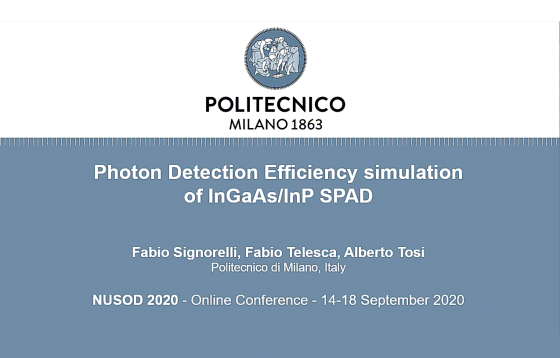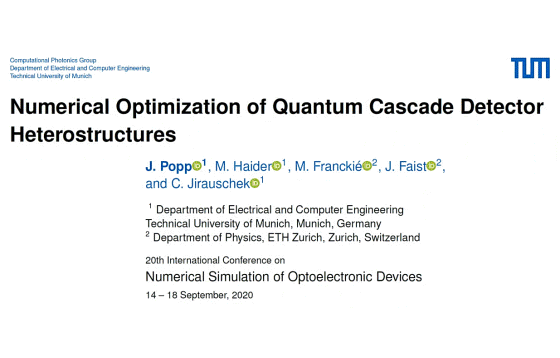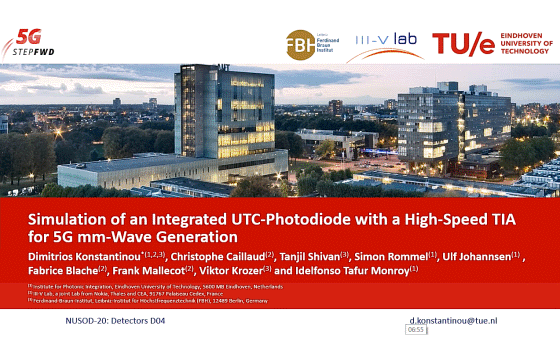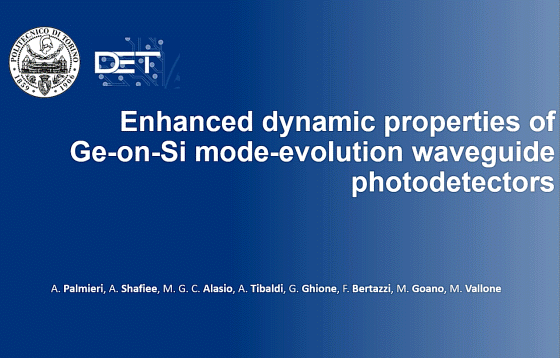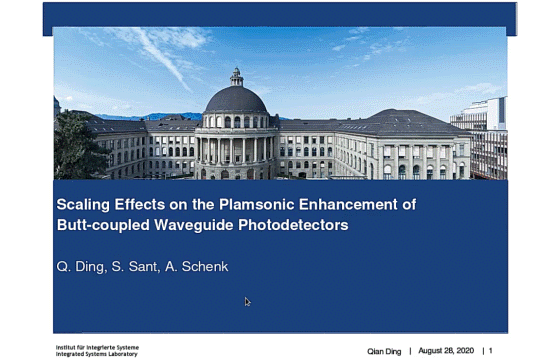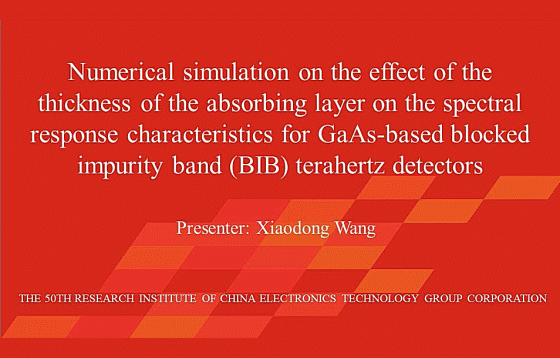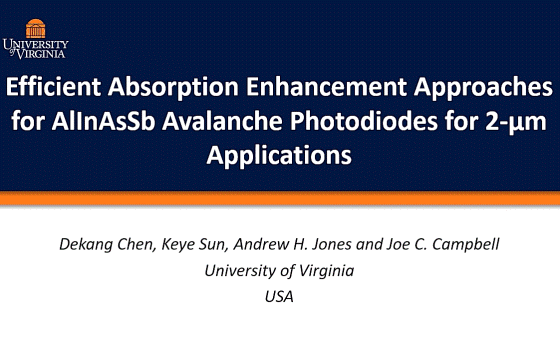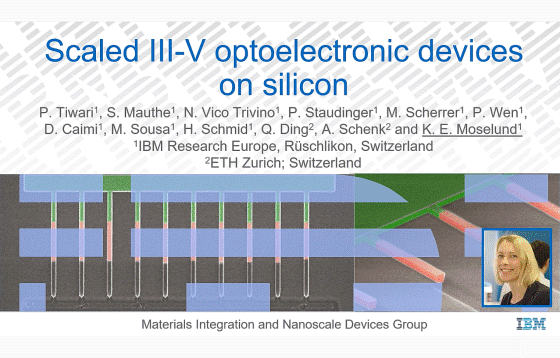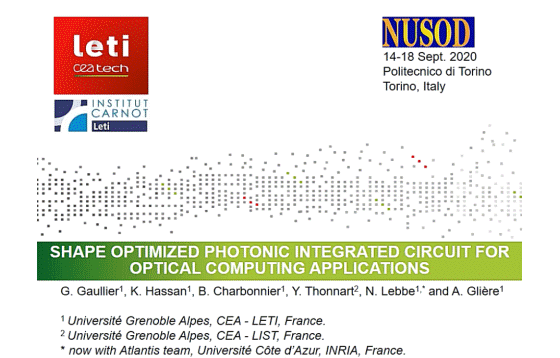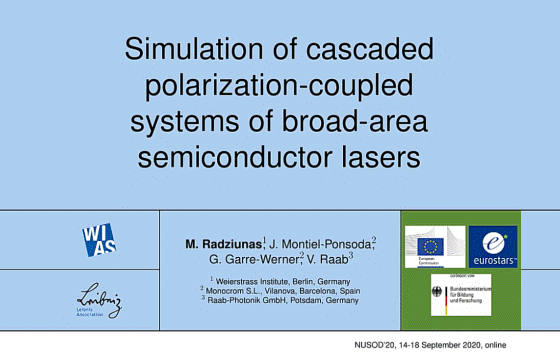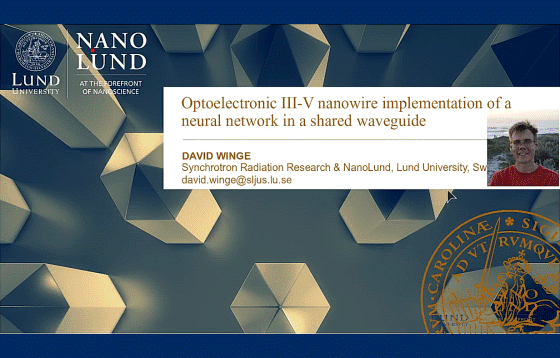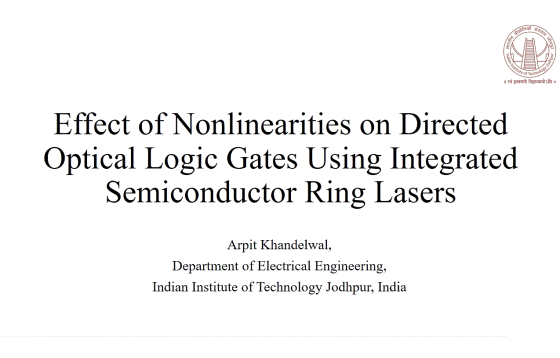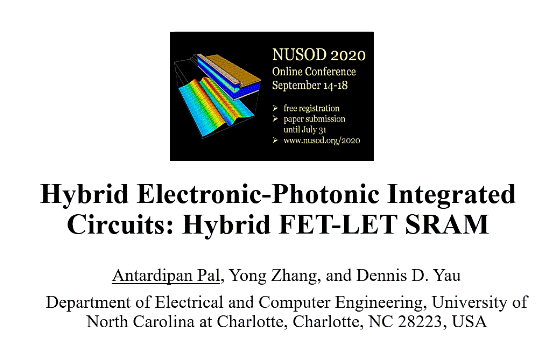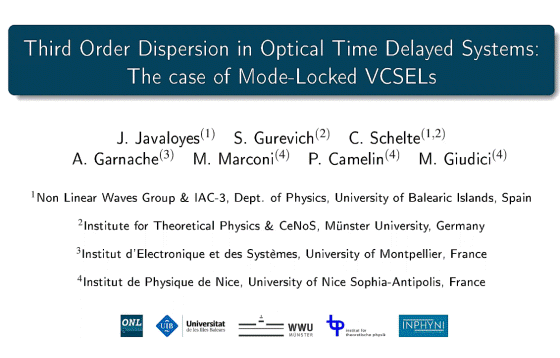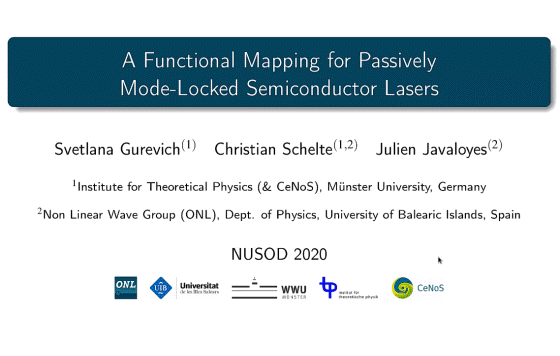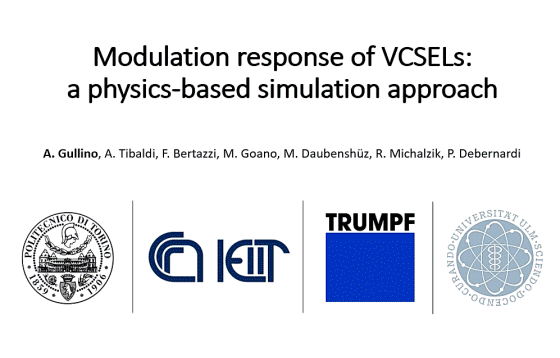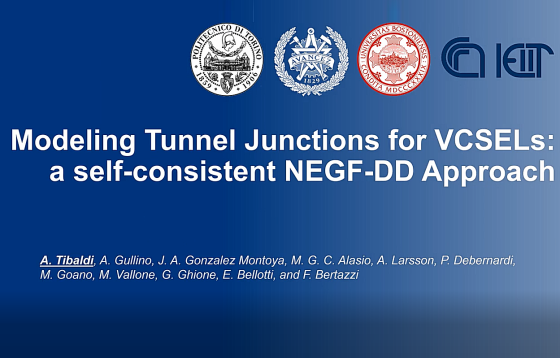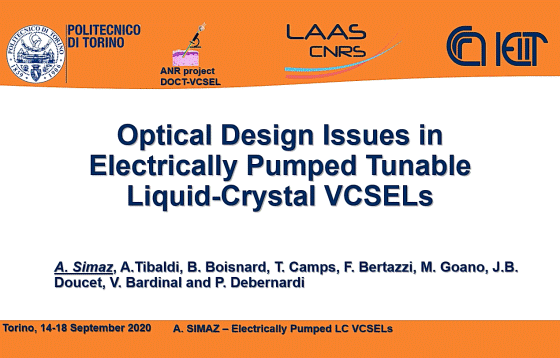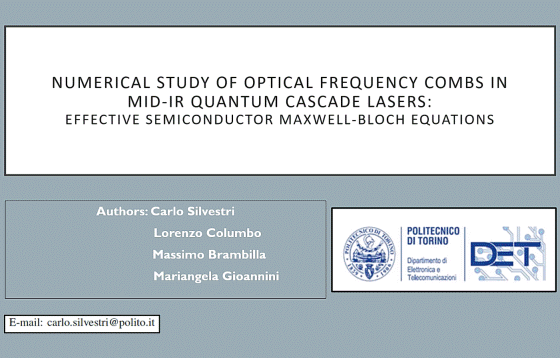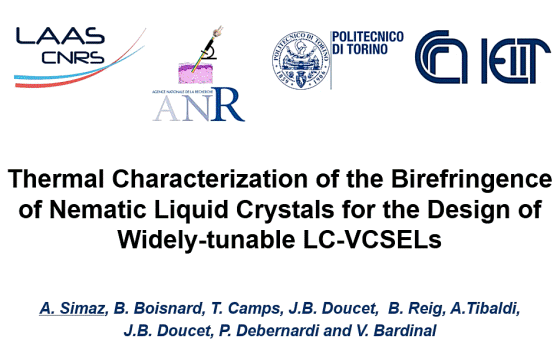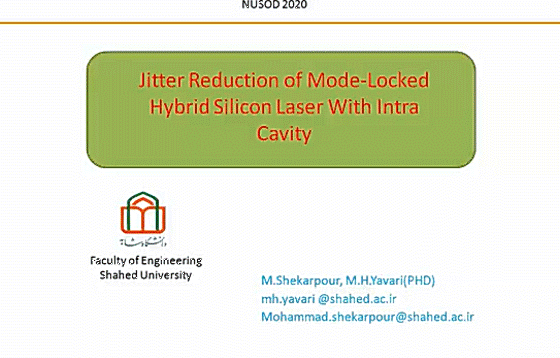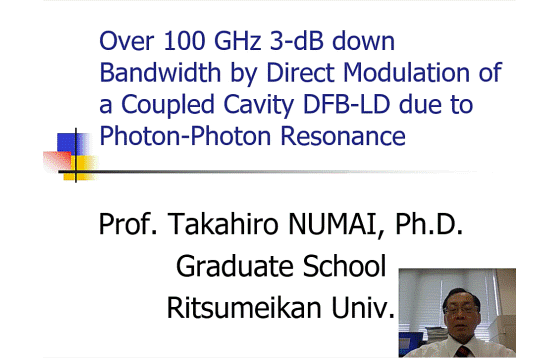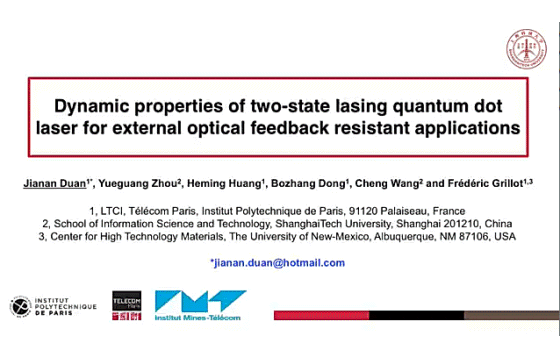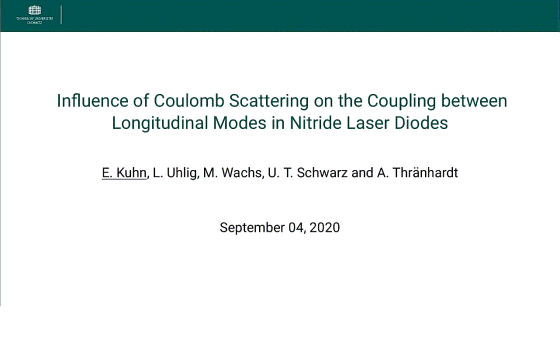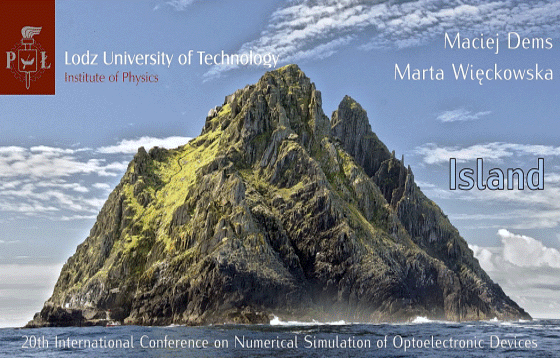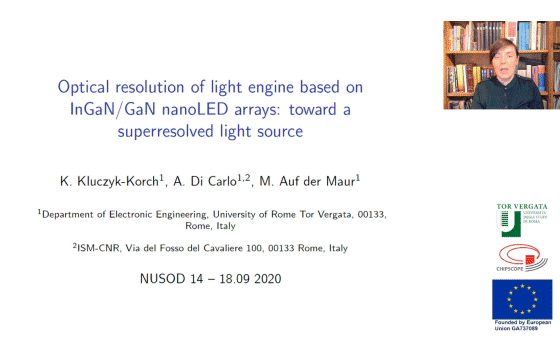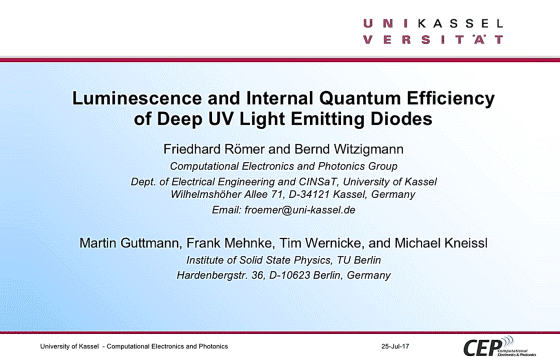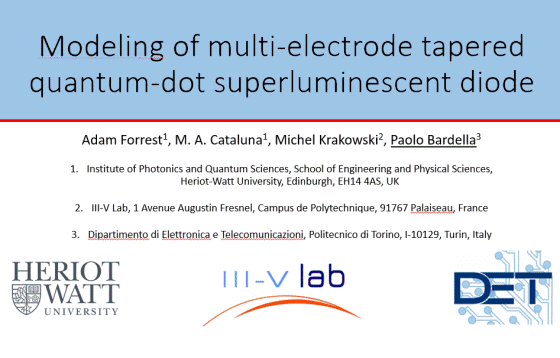


We present three-dimensional simulations of HgCdTe-based focal plane arrays (FPAs) with two-color and dual-band sequential infrared pixels having realistic truncated-pyramid shape taking into account the presence of compositionally-graded transition layers. Simulations emphasize the importance of a full-wave approach to the electromagnetic problem, and the evaluations of the optical and diffusive contribution to inter-pixel crosstalk indicate […]
D02–Photon Detection Efficiency simulation of InGaAs/InP SPAD
We present a comprehensive simulation flow for the estimation of photon detection efficiency as a function of wavelength in InGaAs/InP single-photon avalanche diodes (SPADs) at low temperature. We introduce a joint modelling of electrical and optical properties for SPAD detectors. We also highlight how accurately different parameters have to be calibrated in order to achieve […]
D03–Numerical Optimization of Quantum Cascade Detector Heterostructures
We demonstrate a Bayesian optimization framework for quantum cascade (QC) devices in the mid-infrared (mid-IR) and terahertz (THz) regime. The optimization algorithm is based on Gaussian process regression (GPR) and the devices are evaluated using a perturbed rate equation approach based on scattering rates calculated self-consistently by Fermi’s golden rule or alternatively extracted from an […]
D04– Simulation of an Integrated UTC-Photodiode with a High-Speed TIA for 5G mm-Wave Generation
This work introduces a subsystem level cosimulation for generation, boosting and transmission of millimeter wave signals for 5G applications. The simulation processes to model the full equivalent circuit of uni-traveling carrier photodiodes based on reflection coefficient measurements are analyzed. The optoelectronic lumped equivalent is co-integrated with a transimpedance amplifier design synthesized by high speed transistors. […]
D05–Enhanced dynamic properties of Ge-on-Si mode-evolution waveguide photodetectors
This work discusses coupled three-dimensional electromagnetic and electrical simulations of a Ge-on-Si waveguide photodetector where light is fed through a lateral waveguide. The numerical results show that this coupling solution leads to more uniform photon and carrier distributions along the Ge absorber compared to a conventional butt-coupled detector, allowing a broader electrooptical bandwidth for high […]
D06–Scaling Effects on the Plasmonic Enhancement of Butt-Coupled Waveguide Photodetectors
We employed 3D opto-electrical simulations to study the scaling effects of a plasmonic structure on the optical performance of butt-coupled waveguide photodetectors by placing an Ag stripe on top of the intrinsic region. It is found that cut-offs which are limited by carrier drift in the high-field region of the non-plasmonic device improve with longer […]
D07–Numerical simulation on the dependence of carrier transport characteristics on the thickness of the absorbing layer for GaAs-based blocked impurity band (BIB) terahertz detectors
The dependence of carrier transport characteristics on the thickness of the absorbing layer for Gallium Arsenide (GaAs) blocked-impurity-band (BIB) terahertz detector has been investigated in detail. It is found that responsivity linearly increases with the increased thickness of absorbing layer first, and after achieving a peak value, and then starts to dropping slowly.
D08–Numerical simulation on the effect of the thickness of the absorbing layer on the spectral response characteristics for GaAs-based blocked impurity band (BIB) terahertz detectors
The effect of the thickness of the absorbing layer on the spectral response characteristics for Gallium Arsenide (GaAs) blocked-impurity-band (BIB) terahertz detector has been investigated in detail. It is found that Response bandwidth (BWR) is approximately a linear function of hAbs, and the relationship between the Response bandwidth (BWR) and hAbs has been given in […]
D09–Efficient Absorption Enhancement Approaches for AlInAsSb Avalanche Photodiodes for 2-μm Applications
We describe two photon-trapping structures to enhance the quantum efficiency of AlInAsSb APDs for 2-μm detection. Finite-difference time-domain (FDTD) simulations show the absorption can be enhanced by more than 100 % with a triangular lattice photonic crystal, and nearly 400 % by applying a metal grating, for normal incidence at 2 µm.
IS01–Scaled III-V optoelectronic devices on silicon
In the present talk we discuss the development of the epitaxial technique Template-Assisted Selective Epitaxy (TASE) and its application for the monolithic integration of scaled III-V active photonic devices on silicon. A unique advantage of TASE for silicon photonics applications is that it enables a truly local integration of III-V material at precisely defined positions, […]
IS02–Shape Optimized Photonic Integrated Circuit for Optical Computing Applications
Shape optimization techniques were quite recently applied to photonic components but to the best of our knowledge, no application to optical computing has been reported yet. Here, we present the design of a photonic integrated circuit, composed of shape optimized passive components, performing a matrix-vector product. A ≈ 2000 times gain on the overall footprint […]
IS03–Simulation of cascaded polarization-coupled systems of broad-area semiconductor lasers
We present a brightness- and power-scalable polarization beam combining scheme for high-power, broad-area semiconductor lasers. To achieve the beam combining, we employ Lyot-filtered optical reinjection from an external cavity, which forces lasing of the individual diodes on interleaved frequency combs with overlapping envelopes and enables a high optical coupling efficiency. We demonstrate how repeatedly introduced […]
IS04–Optoelectronic III-V nanowire implementation of a neural network in a shared waveguide
Neural node components consisting of III-V nanowire devices are introduced. This allows for the construction of a small footprint specialized neural network. A broadcasting strategy is developed which removes the need for inter-node wiring. As a model system, an insect brain navigational circuit is chosen and successfully emulated using the introduced nodes and network architecture. […]
IS05–Effect of Nonlinearities on Directed Optical Logic Gates Using Integrated Semiconductor Ring Lasers
Nonlinearities in the semiconductor ring laser (SRL) are incorporated in the analysis of directed optical logic gates and their effects on the output are studied. The paper discusses the effects of gain medium linewidth, internal quantum efficiency and self and cross gain saturation on the output of directed optical NOT gate implemented using SRLs.
IS06–Hybrid Electronic-Photonic Integrated Circuits: Hybrid FET-LET SRAM
High speed, low power, low leakage, and low noise circuits are extremely essential for modern VLSI chips. Since on-chip cache memories consume appreciable amount of the total chip area and energy, high performance and low power Static Random-Access Memories (SRAMs) are needed for high performance and low power electronic systems. A hybrid FET-LET 6T SRAM, […]
LD01–Third Order Dispersion in Optical Time Delayed Systems: The case of Mode-Locked Vertical External-Cavity Surface-Emitting Lasers
Time-delayed dynamical systems materialize in situations where distant, point-wise, nonlinear nodes exchange information that propagates at a finite speed. However, they are considered devoid of dispersive effects, which are known to play a leading role in pattern formation and wave dynamics. We show how dispersion may appear naturally in delayed systems and we exemplify our […]
LD02–A Functional Mapping for Passively Mode-Locked Semiconductor Lasers
We present a modern approach for the analysis of passively mode-locked semiconductor lasers that allows for efficient parameter sweeps and time jitter analysis. It permits accessing the ultra-low repetition rate regime where pulses become localized states. The analysis including slow (e.g. thermal) processes or transverse, diffractive dynamics becomes feasible. Our method bridges the divide between […]
LD03–Modulation response of VCSELs: a physics-based simulation approach
A preliminary study of the dynamic behaviour of a GaAs/AlGaAs 850 nm VCSEL is presented, with the focus on the small-signal analysis and in particular on the optical amplitude modulation response. Simulations are performed with our in-house quantum-corrected one-dimensional drift-diffusion code D1ANA, updated to perform the AC analysis. The -3 dB cutoff frequency of the […]
LD04–Modeling Tunnel Junctions for VCSELs: A Self-Consistent NEGF-DD Approach
In this work we investigate carrier transport in tunnel junctions for vertical-cavity surface-emitting lasers by a novel self-consistent simulation framework for semiconductor quantum devices. Based on a Poisson-drift-diffusion foundation, in this approach quantum features are described through a nonequilibrium Green’s function formalism. The simulator is validated through a comparison with experimental results.
LD05–Optical Design Issues in Electrically Pumped Tunable Liquid-Crystal VCSELs
In this work we investigate a tunable 850nm laser based on a hybrid combination of a liquid crystal micro-cell and a half GaAs VCSEL. The target application is optical coherence tomography. The inherent tolerances of the hybrid technology, the presence of metals in the cavity and the need for a pure extraordinary mode lasing make […]
LD06–Numerical Study of Optical Frequency Combs in mid-IR Quantum Cascade Lasers: Effective Semiconductor Maxwell-Bloch Equations
In this paper a theoretical model based on Effective Semiconductor Maxwell-Bloch Equations (ESMBEs) is proposed for the description of the dynamics of a multi-mode mid-Infrared (mid-IR) Quantum Cascade Laser (QCL) in Fabry Perot (FP) configuration, in order to investigate the spontaneous generation of frequency combs in this device. In agreement with recent experimental results our […]
LD07–Thermal Characterization of the Birefringence of Nematic Liquid Crystals for the Design of Widely-tunable LC-VCSELs
In this work, the thermo-optical properties of nematic liquid crystals are investigated through localized reflectance spectra measurements performed on a tunable LC-filter. The final aim is to insert such LC in the cavity of a tunable VCSEL device, in which local self-heating due to optical or electrical pumping must be taken into account. We demonstrate […]
LD08–Jitter Reduction of Mode-Locked Hybrid Silicon Laser With Intra Cavity Filter
We study the influence of the intra-cavity ring on dynamics, phase noise and timing jitter of a long-ring-cavity colliding pulse mode-locked laser using a delay differential equation (DDE) model. The results of dynamic show that the intra-cavity filter can suppress harmonics of 2 GHz cavity. We also find a reduction of phase noise and timing […]
LD09–Over 100 GHz 3-dB down Bandwidth by Direct Modulation of a Coupled Cavity DFB-LD due to Photon-Photon Resonance
This paper reports on 3-dB down bandwidth of 110.6 GHz by direct modulation of a coupled cavity DFB-LD with phase-shifted/uniform gratings due to photon-photon resonance when the injected current is 3.5 times the threshold current.
LD10–Dynamic properties of two-state lasing quantum dot laser for external optical feedback resistant applications
This work investigates the dynamics of two-state quantum dot lasers through semi-analytically solving a set of rate equations. Simulations reveal that the occurrence of excited state lasing reduces the damping factor of the laser while increases the linewidth enhancement factor associated to the ground state transition. These results are in good agreement with the experimental […]
LD11–Influence of Coulomb Scattering on the Coupling between Longitudinal Modes in Nitride Laser Diodes
Due to their small separation of longitudinal modes, Fabry-Perot type laser diodes show rich mode competition effects. For example streak camera measurements show cyclic mode hopping, where the currently active longitudinal mode changes from lower to higher wavelengths. This effect can be explained by beating vibrations of the carrier densities in the quantum wells and […]
LD12–Modeling Impact of Oxide Island on the Lasing of ARROW-VCSEL
We analyze the impact of a low-refractive antiresonant oxide island buried in a top VCSEL mirror on the lasing conditions of lateral modes of different orders. By performing comprehensive thermal, electrical, and optical numerical analysis of the VCSEL device, we show the impact of the size and location of the oxide island on the current […]
LED01–Optical resolution of light engine based on InGaN/GaN nanoLED arrays: toward a superresolved light source
We present the optical simulations of a novel illumination source based on nanoLED arrays for the possible application in superresolved microscopy. We are simulating the images of various gold nanoparticle arrangements collected by the proposed nanoillumination microscope. The images are then analysed in order to understand the capabilities and limitations of the microscope.
LED02–Luminescence and Internal Quantum Efficiency of Deep UV Light Emitting Diodes
Deep ultraviolet (DUV) light emitting diodes (LED) made of Aluminium Gallium Nitride (AlGaN) are increasingly considered as light sources for medical as well as material processing applications. Recent research on AlGaN DUV LEDs focuses on the enhancement of the efficiency. The efficiency of AlGaN LEDs is limited by a low hole injection efficiency and TM-polarized […]
LED03–Modeling of multi-electrode tapered quantum-dot superluminescent diode
We introduce a rate equation based numerical model suitable for the description of the wide spectral asymmetry experimentally observed at the two facets of multi-electrode tapered superluminescent diode based on Quantum Dot material. Numerical simulations carried out with this model were able to quantitatively reproduce the behavior of a two-section SLD and explain the reported […]

